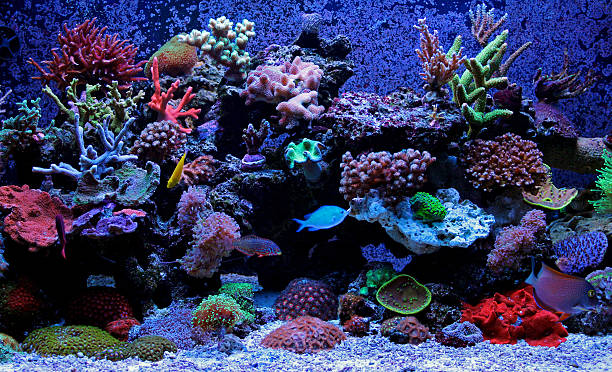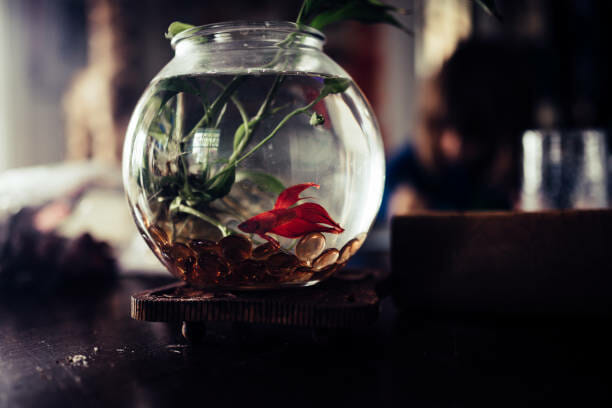How to Increase Co2 In Aquarium
If the fish in your aquarium are sharing their living space with plants, you are likely aware that they require Co2 if they are going to grow and flourish. You may be surprised to learn, however, that about 40% of a plant is composed of carbon. Yet if C02 levels in the water become too high, that can be disastrous for your fish. That is why you must be careful to maintain the fragile balance that will be beneficial to both your fish and plants and keep them all one happy family.
The subject of this guide is how to increase Co2 in an aquarium without hurting the fish. We also examine the indications of too much Co2 in the water, and explain how to test Co2 levels the aquarium to keep them at a healthy level for both plants and fish.
Perhaps you are unaware of this, but adding Co2 to your aquarium can alter the pH levels along with the hardness of the water, which could make the parameters unsuitable for some species of fish?
Table of Contents
Significance of Co2 in Your Aquarium
Aquatic plants require carbon dioxide (Co2) combined with micro and macronutrients plus light, in order to develop the nutrients that they need to grow and stay healthy. Photosynthesis is the process through which plants make energy. It occurs when light binds Co2 with water to produce sugar from which the plant gets its nutrition. This process takes place in the daytime, and the plant expels oxygen (O2), which is utilized by the fish and other living creatures in the aquarium. When night comes and there is no light, the plant respires in reverse, creating Co2 and using oxygen.

Co2 Above and Beneath the Waterline
Things are easier for floating aquarium plants. Because surface plants can regularly obtain all the Co2 they need from the air, where it exists in abundance. That is why floating aquarium plants will always have enough Co2. It’s a different story with submerged aquatic plants. Due to the fact that the C02 levels in water drop to about 2 to 4 mg/l, which is not enough for submerged aquatic plants to remain healthy.
Co2 in the Aquarium
It is not unusual for a home aquarium to fall short of the necessary Co2 for various species of plants, and the only way to remedy that is by giving C02 artificially by way of a Co2 system. There are, however, some plants that can do quite well in the home tank without Co2 supplementation.
One example of this would be certain types of ferns, like Anubis’s, and Cryptocoryne. These are a group of slow-growing plants, which require little light and can stay vigorous simply by making use of the Co2 that is produced by the bacteria, fish, and other plants in the aquarium.
Measuring the Level of Co2 in an Aquarium
Using a gas injection system is one common and effective method of adding C02 to an aquarium. This will certainly benefit your plants, but you must remember that Co2 is extremely toxic when too much is absorbed and what’s good for your plants may ultimately kill your fish and invertebrates. That’s why it’s vital that you monitor and test the amount of gas in the water on a regular basis.
Safe Co2 Levels
Normally fish and invertebrate species can survive happily and safely in water containing a Co2 content of 30 ppm (mg/l). Be that as it may, the toxicity threshold can radically change, according to the amount of dissolved oxygen that is in the water. In aquariums where the levels of oxygen are low, the fish will be greatly affected by the toxicity of Co2. But in water with high amounts of dissolved oxygen, the safe threshold of Co2 rises.
Gas Toxicity
If you relax your vigilance and let the Co2 levels in your tank rise too high, the amount of carbon dioxide in the water will turn toxic for your livestock. Indications of this are:
- Loss of appetite
- Lethargy
- Gasping at the water’s surface
- Loss of consciousness
At this point you must quickly to save the lives of your fish. The fastest and most efficient method is to reduce the Co2 level in the water by performing an immediate large water change. Before you do this, however, be certain that the water is dechlorinated and the same temperature as that which is in the tank so that your fish will not experience even more stress or temperature shock.

Danger at Night
Most fish experience Co2 intoxication at night when aquatic plants use oxygen and produce Co2, increasing the toxicity that is already in the tank. This is why you should turn your Co2 injection system off just before going to bed.
How to Add Co2 to Your Aquarium
There are several ways in which you can increase Co2 in an aquarium. The most frequently used and safest method is to enlist the power of a pressurized tank of Co2 that comes with an attached solenoid regulator with tubing hooking up to a diffuser in or outside of the aquarium. Now don’t worry if you haven’t a clue as to what we’re talking about. Everything is going to be explained step by step.
Getting Started With Co2, the Tank
There are several options you can choose from, however, the recommended best choices are either a conventional 5+lb tank or a 20oz paintball tank. For an aquarium that is less than 30 gallons, your ideal selection is the smaller paintball setup. If you want to set up multiple tanks or an aquarium that’s 40 gallons or larger, then you require the bigger 5lb tank.
Before you decide upon your type of tank, determine whether or not you have a paintball/airsoft store nearby where you can conveniently refill your smaller tanks.
The Co2 Regulator Plus Solenoid
Be absolutely certain that your tank has an integrated solenoid. When Co2 is added to an aquarium in high amounts, you only want the Co2 to be running when the lights are on. For this you must have a way to plug the regulator into a timer. Without a solenoid, you can’t do this unless you were to tackle the job manually, and that is highly not recommended.
Furthermore, do not buy the cheapest regulator you can find. The less a regulator costs, the more likelihood that it will malfunction and the result could be that most, if not all of your fish wind up dead.
Every regulator comes with a manifold with an integrated bubble counter. There is a pro and premium version, with the premium usually being made to attach as many as three Co2 outputs.
What Is a Bubble Counter?
This is a part of your Co2 system that is an indicator of how much Co2 is actually going into your tank at any given time. The best case is if you get a bubble counter that is included with both the pro and premium regulators and is actually attached to them.
Co2 Proof Tubing
The next item that you need is the tubing that will go from your regulator and lead straight to your aquarium. The best scenario is if the tubing connects right to the bubble counter on the regulator. It’s ok to use clear vinyl tubing for this, as it will work just fine, however, you can also obtain special Co2-proof tubing, which will serve to keep Co2 from passively leaking into your aquarium.
Check Valve
You would ordinarily put your check valve somewhere in the tubing line leading to your tank. What it does is to keep a back flow of water from moving back towards the regulator. Ideally, your bubble counter should have an integrated check valve.
The Diffuser
While there are many options when you are diffusing Co2 in an aquarium, the most frequently used way is by utilizing an in-tank diffuser. This permits Co2 to effectively enter your tank. A sponge-like medium will be used in order to break down gaseous Co2 into bubbles, so that it is easier for your aquarium to draw them in. The best position for your diffuser is opposite the outlet. This will allow the flow from the filter to push the bubbles through the water column for improved diffusion.
A word of warning here, do not use a regular airstone as a Co2 diffuser. It’s crucial that you make the bubbles as small as they can be so that you don’t waste your Co2.
The best way to mix Co2 with the water in your aquarium and get maximum effect is to use an in-line diffuser. These diffusers attach in-line with the outflow, not inflow of your canister filter. Regular in-tank diffusers depend on making extra small bubbles that will have enough time to mix with your water before they escape the system at the top of the tank. They work particularly well on smaller volumes of water.
Drop Checker
A specialized kit that measures the amount of Co2 that has been diffused in water. Consider it to be a vessel that carries a solution called bromothymol blue that will change color according to the concentration of Co2 in your aquarium. The color of the liquid must be GREEN which means the concentration is exactly where it should be.
Spanner
A type of wrench employed for tightening up the regulator to halt leakage.

Pressurized Co2 Setup Guide
- Connect all the components – The easiest way to do this is to begin by tightening the regulator with the spanner and then connect it to the Co2 tank. Put the diffuser inside the tank, and be certain that it is placed correctly. Use Co2 resistant tubing to connect the diffuser and bubble counter. If you have purchased a solenoid valve separate from the regulator, now is the time to attach it to the regulator.
- Open the needle valve – Partially open the needle valve that is on your regulator, but just slightly. This will ensure that your solenoid isn’t damaged when the main valve of the bottle is released.
- Switch on the main valve of the bottle – This will release Co2. If the bottle is full, the gauge should read 800-1000 psi.
- Release Co2 from the regulator – Do this by slowly turning the needle valve and keeping an eye on the bubble counter so that you can adjust the rate.
- Adjust the needle valve so you can see 1-2 bubbles per second – For larger aquariums, you will need more. Be patient when fine tuning, because the needle valves can be fragile and you don’t want to break it.
- Monitor the drop checker for several hours – Take note of what color is being displayed. Dark blue means high pH/low Co2 while yellow indicates low pH/high Co2. Adjust the Co2 needle valve until the liquid turns green. You have to remember that the drop checker indicates the amount of Co2 that was present as of 1 hour ago. This is because it takes 1 hour to respond to the Co2 level.
- Set the electric timer so the solenoid can shut off the Co2 regulator – Set the timer to turn on 1 hour before the lights turn on and turn off 1 hour before the lights turn off.
Carbon Dioxide Co2 injection has a long history of being used in planted fish aquariums. Its major advantage is producing much greater plant growth which aids in creating a safe and healthy environment for your fish and any other critters living in your aquarium.
Co2 Mistakes
- Dry ice — Never put dry ice into your aquarium. Yes, it’s true that it does release carbon dioxide, but when it comes in contact with water, dry ice explodes, creating large, violent bubbles. Any severe agitation of the surface of the water or bubbling of air through the water will make the Co2 escape into the atmosphere as fast as it is added, leaving the plants and fish with very little Co2 for their needs. You should be further aware that dry ice has an oil that is not healthy for aquatic life, and involves human safety risks when handling it as well.
- Co2 tabs – Only use Co2 tabs in an aquarium that is extremely small, as they are apt to be inefficient for long term use.
- Monitoring Co2 levels – After you have added Co2 to your aquarium, you cannot simply walk away and forget about it. It is absolutely vital that you continue monitoring your carbon dioxide levels together with the health of your water in order to be certain that it remains a healthy environment for all aquatic life.
By maintaining a practical attitude, and staying vigilant, you can create an aquarium environment for your fish and aquatic plants that is not only magnificently beautiful, but also healthy and safe.